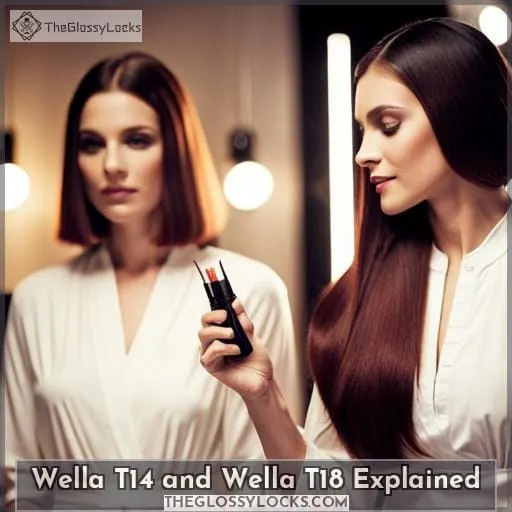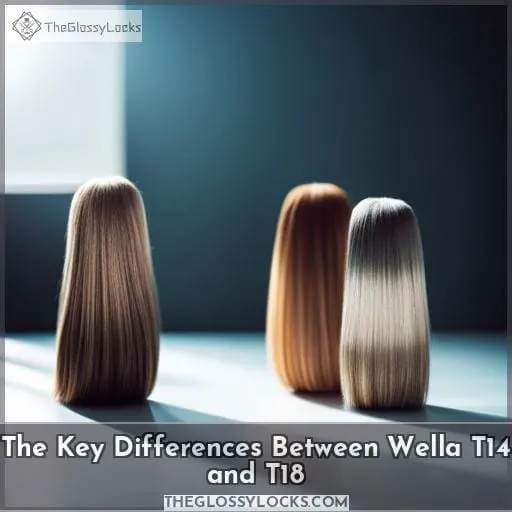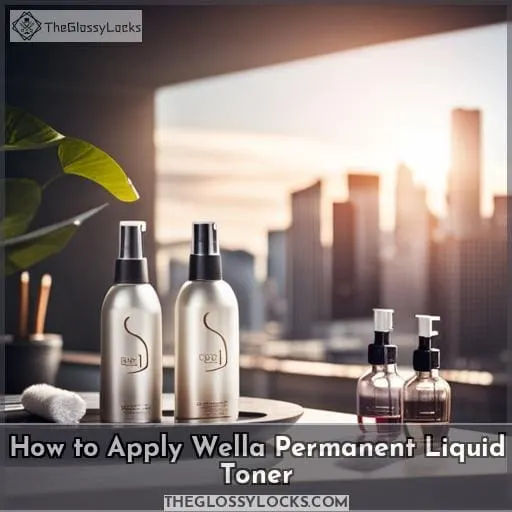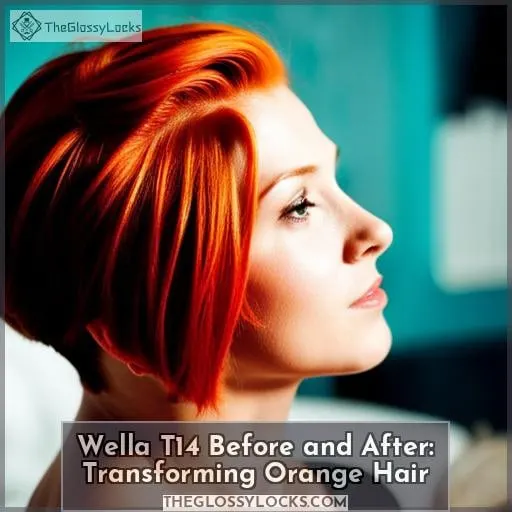This site is supported by our readers. We may earn a commission, at no cost to you, if you purchase through links.
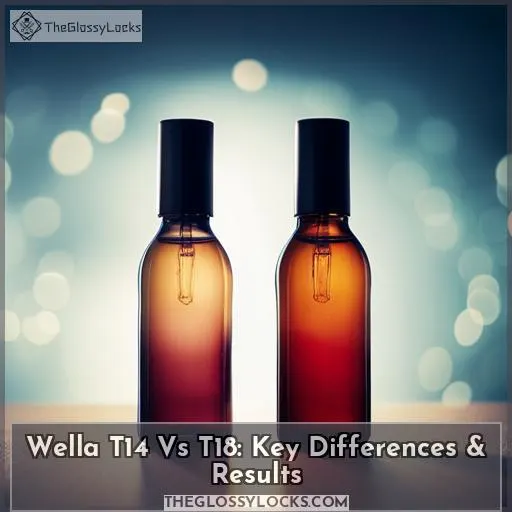 Confused about the differences between Wella T14 and T18? You’re not alone. Many face a difficult choice in selecting the right toner to get their desired look – whether it be platinum blonde or beachy waves.
Confused about the differences between Wella T14 and T18? You’re not alone. Many face a difficult choice in selecting the right toner to get their desired look – whether it be platinum blonde or beachy waves.
Fortunately, you can easily make an informed decision by understanding how each of these popular Wella toners works and what they are designed to achieve.
This article will compare key differences between Wella T14 vs T18 as well as discuss results, application tips for even coverage, hair level undertones, and maintenance advice for further toning – so that you can confidently choose the best option for your needs!
Table Of Contents
- Key Takeaways
- Wella T14 and Wella T18 Explained
- The Key Differences Between Wella T14 and T18
- Understanding How Wella Toner Works
- Will Wella Toner Damage My Hair?
- Choosing the Right Wella Toner for Your Needs
- How to Apply Wella Permanent Liquid Toner
- Additional Tips for Achieving the Best Toning Results
- Can You Use Both Wella T14 and T18 Together?
- Wella T14 Before and After: Transforming Orange Hair
- Conclusion
Key Takeaways
- Wella T14 and T18 are popular toners for achieving ash blonde shades.
- Mixing T14 and T18 can create a unique ashy tone.
- Use a 20-volume developer to minimize hair damage.
- Apply toner starting from the back for even coverage.
Wella T14 and Wella T18 Explained
You can choose between Wella T14 and T18 depending on your hair’s level, undertones, and desired results. T14 is for neutralizing orange tones or yellow hair, while T18 is ideal for achieving a cool ash-blonde shade on level 10 or higher.
To get the best out of either toner, use a lower volume developer like 20 to minimize potential damage. Apply it in small sections using a non-metallic bowl or applicator bottle with a 1:2 ratio of toner to developer.
Follow the box instructions, but do not exceed 30 minutes processing time before rinsing off with sulfate-free shampoo and conditioner. Use purple shampoo regularly afterwards to keep brassiness at bay. You may need multiple sessions if you’re after the perfect icy blonde.
For light blonde hair, color-enhancing violet base shampoos should be used instead. They enhance tone balance better than bleach alone when lifting colors from dark blondes to lighter shades like pale ash blonde (T14) or lightest ash blonde (T18).
If your current hue has gone too far towards reds or oranges, mix both products together for a unique look that cancels out undesired hues. Take into account each individual’s porosity levels and equalization needs before any application.
The Key Differences Between Wella T14 and T18
Are you considering toning your hair to create an icy blonde shade? Wella T14 and T18 are two popular permanent colors from Wella. While they both can produce beautiful results, there are key differences between them that should be considered before deciding which one is right for you.
The main difference lies in color description—T14 has a pale ash-blonde hue with violet-blue tones, while T18 is the lightest ash blonde with a violet base. To ensure successful application, consider your hair’s level and undertones when choosing the right toner for your needs—T14 works best on orange/coppery tones whereas T18 neutralizes yellow or honey blondes better than other products.
It’s also important to use the correct developer volume; lower concentrations (like 20) help minimize potential damage to strands but may not provide enough lift if you have darker levels of hair color than what’s specified by each product package instructions.
For those looking for something unique, mixing these two colors can create an even more ashy tone that complements platinum blondes but it’s difficult to get consistent results without prior experience in coloring techniques so proceed with caution! Additionally, equalizing porosity helps achieve even-toned looks after rinsing out the toners –use timers as recommended on box directions and follow up afterwards using sulfate-free shampoo conditioners specifically designed for colored tresses like purple shampoos which will keep brassiness at bay over time too!
Understanding How Wella Toner Works
To achieve the perfect ash-blonde shade, it is important to understand how Wella toner works. When toning your hair, having a grasp of color theory and hair porosity is crucial. Additionally, selecting the right developer can help you achieve the desired result while minimizing damage to your locks.
For even coverage, it is recommended to apply the toner in thin sections. Mixing different tones allows you to customize your look based on your individual needs and preferences.
To achieve the ideal ash-blonde tone between Wella T14 and T18, there are a few steps you can follow. First, consider the level of orange or yellow hues present in your hair. Then, opt for a lower volume developer, such as 20, instead of 30 or 40.
It is also advisable to perform strand tests beforehand to check for allergies and preview the results.
When applying the toner, mix 1 part toner with 2 parts developer in a non-metallic bowl or applicator bottle. Apply small amounts at a time, starting from the back and working towards the front.
After the processing time has passed (maximum 30 minutes), it is recommended to use purple shampoo regularly.
Equalizing hair porosity is important to prevent uneven results. Additionally, selecting the appropriate volume of developer depends on the condition of your hair. If your hair is damaged, opt for a 10-volume developer. If your hair is stronger, a 20-volume developer should suffice.
By following these steps, you can achieve a beautiful blonde hue without causing damage to your delicate strands.
Will Wella Toner Damage My Hair?
When considering whether Wella toner will damage your hair, it’s important to take into account the developer volume used and how carefully you follow the box directions. To ensure minimal damage when using a Wella T14 or T18 toner shade, choose a 20-volume developer for best results.
This is especially true if you’ve already lightened your hair because bleaching can cause some porosity issues that require equalization before applying any color corrections.
Toner application is also key in avoiding potential hair damage. Apply it in thin sections and don’t leave it on longer than 30 minutes to avoid over processing of the strands. When mixing T14 and T18 together, consider both yellow and orange tones present to get even results without compromising your desired tone longevity or balance between hues after application.
Lastly, keep up with regular maintenance such as shampooing with sulfate-free products formulated specifically for colored treated locks.
Choosing the Right Wella Toner for Your Needs
When it comes to choosing the right Wella toner, considering your hair’s level and undertones is key. Application tips such as performing strand and patch tests, mixing toner and developer in a 1:2 ratio using a non-metallic bowl or applicator bottle, and applying toner in small sections for even coverage are important steps that help you achieve desired results with less potential damage.
Proper maintenance of tone can be achieved by using purple shampoo regularly on blonde hair, while further toning may require multiple sessions depending on the look you’re trying to achieve.
Hair level and undertones
Considering your hair’s level and undertones is key when selecting the right Wella toner for you. Color theory can be applied to cancel out unwanted hues, while understanding the differences between T14 and T18 will help determine which one best suits your needs.
For neutralizing orange tones, opt for a pale ash blonde with violet-blue pigments like T14. However, if you desire yellow or honey blonde shades, then choose a lightest ash blonde with a violet base such as T18.
To ensure even coverage of color, work in small sections. Remember to mix toner and developer according to directions before proceeding.
Understanding these fundamentals helps achieve an optimal outcome that meets individual needs!
Application tips for even coverage
To get the best results when applying Wella toner, apply it in thin sections for even coverage and use a non-metallic bowl or applicator bottle to mix the toner and developer with extraordinary precision.
- Sectioning Techniques: Start at the back of your head to ensure thorough saturation.
- Mixing Ratios: Use 1 part toner to 2 parts developer as directed on box instructions for optimal color payoff.
- Toner Application: Work in small sections so you can control how much product is being used, which leads to more uniform coloring overall.
- Porosity Consideration: Equalize hair porosity before application for an even result.
- Developer Selection: Choose 10 volume developer if you have damaged hair, 20 volume if not.
Maintenance and further toning
Maintain your desired look with regular toning and purple shampoo for the perfect ash blonde shade. Toning techniques can help you achieve a natural, even tone that won’t leave you looking brassy or yellow.
Purple shampoo benefits include added pigment to maintain cooler tones in between salon visits. Wella t14 is well-suited for orange tones, while t18 works best on yellow hair. Both require equalizing porosity prior to application for optimal results.
Follow all directions and use 20 volume developer when toning – no higher! For lasting color, stick with sulfate-free shampoos formulated specifically for blonde hair and use purple conditioners as needed.
Don’t forget: achieving lighter colors typically requires lightening first before any type of toner is applied!
How to Apply Wella Permanent Liquid Toner
Applying permanent liquid toner to your hair can be a daunting task. To ensure even coverage, separate your hair into sections before mixing the toner and developer in a 1:2 ratio. Start the application at the back of the head and saturate each section thoroughly for 5-30 minutes – then rinse out with sulfate-free shampoo and conditioner for the best results.
Separate Your Hair in Sections
Before applying toner, divide your hair into small sections for even coverage. Use a sectioning technique to part the hair in an organized way and apply color theory when mixing toners. Carefully separate each layer before starting segmented application of the ash-blonde tint to achieve the desired results with minimal damage.
Mix Toner and Developer
Mix your Wella toner and developer in a 1:2 ratio using a non-metallic bowl or applicator bottle for the best results. To create unique blends, mix T14 and T18 to achieve desired tones. Developer selection depends on hair porosity; use 10 volume for damaged hair, 20 volume for long-lasting color.
Utilize equalization techniques to get an even-toned look with violet/blue pigment from T14’s purple base balancing out yellow undertones of T18.
Apply Toner Starting at the Back
Start by applying the toner in small sections at the back of your head for even coverage. For best results, ensure you have done a strand test and chosen an appropriate developer volume for your hair’s porosity.
Mixing ratios should be 1:2 with a non-metallic bowl or applicator bottle to avoid discoloration. Consider color wheel principles to cancel out orange undertones using purple shampoo and blue base tones from T14 before moving onto lighter shades like T18.
Let Toner Sit for a Few Minutes
Allow the toner to sit on your hair for a few minutes before rinsing off for the best results. To achieve optimum effectiveness, it is important to determine which Wella T14 or T18 permanent liquid toner is right for you based on your hair type and color.
Follow the mixing ratios with the developer and apply it in small sections; the process time varies from 10-30 minutes depending on the desired result. Use a porosity equalizer to ensure even coverage, then rinse out with sulfate-free shampoo post-application.
Wash Out Toner With Your Favorite Shampoo and Conditioner
Rinse out the toner with sulfate-free shampoo and conditioner to reveal your beautiful new ash blonde shade. Invest in quality products for the best results, preserving color and protecting hair health.
Conditioning ingredients help maintain moisture balance while providing a glossy shine. Toners are powerful, so remember not to leave them on for too long, or else you might experience brassy tones! For post-toning care, regularly use purple shampoos for better tonal maintenance over time.
Additional Tips for Achieving the Best Toning Results
Sneak a peek at the end results of your toning journey with a strand test first! To ensure you get the best possible result, consider these additional tips:
- Understand hair porosity and equalize it for an even-toned look. Use a timer to avoid leaving toner on too long and select a developer that matches your hair condition (10 volume for damaged hair, 20 volume for lasting color).
- Carefully mix Wella T14 and T18 based on the yellow and orange tones in your hair to achieve the desired shade. However, be aware that achieving the perfect balance may require multiple sessions or the use of other products like purple shampoo in between.
- Consider the principles of color theory when selecting which Wella toners to use. Choose either T14 or T18 depending on whether you have more yellow/honey blonde hues (T18) or orange/coppery tones (T14).
- If you are planning a double process that involves pre-lightening followed by toning, it is best to consult a professional stylist. This process can potentially result in undesired orange shades if done incorrectly.
When used correctly with an understanding of the individual’s needs in mind, along with proper application techniques according to the box directions, both Wella permanent liquid toners provide a great opportunity to create beautiful ash blonde shades while minimizing potential damage due to overprocessing.
Can You Use Both Wella T14 and T18 Together?
Surprise yourself by experimenting with mixing Wella T14 and T18 to create a unique ash-blonde tone. Mixing the two toners can help you achieve an even more customized shade according to your individual hair needs.
Combining these popular toners is not as difficult as it may seem, but there are certain tips and tricks that will ensure the best results.
When combining Wella T14 and T18, consider both your hair’s yellow undertones as well as its orange undertones. This will help you determine the right ratio of each product needed to achieve the perfect color balance for your hair.
To ensure an even application, apply the toners in thin sections throughout your entire head before the processing time expires.
It’s also important to equalize the porosity of your hair before applying the toners. This will help create a better end result, as different strands of hair absorb color differently. To equalize porosity, you can use a timer when applying the toners or select a developer volume based on the health of your hair.
If your hair has been recently damaged, a 10-volume developer should suffice. If your hair is in better condition, a 20-volume developer will provide longer-lasting effects.
Wella T14 Before and After: Transforming Orange Hair
Transform your orange hair to a cool, pale ash blonde with Wella T14 and watch the vibrant violet-blue tones take over.
With before and after transformations, you can expect:
- A noticeable change in color from orange to an icy blonde shade.
- A boost of confidence as you admire the results of your hard work.
- Enjoyment at watching friends and family marveling at how different it looks!
Wella T14 is perfect for those wanting to neutralize their remaining orange tones with blue pigments, while still enjoying lightened locks that are naturally beautiful looking instead of damaged or brassy hues common among other toners.
But be sure not to apply this product on level 10 hair or higher; use Wella T18 if so, since the best results come from its violet base, which creates a brighter hue than what can be achieved by using just one toner alone!
And don’t forget about equalizing hair porosity either – this will help ensure an even application throughout all sections for optimal success when transforming tresses from dull oranges into luxurious golden blondes!
Use developer volume between 20 – 40 depending on the desired outcome, paired with 1:2 ratio mixing instructions located inside the box packaging for reliable maintenance tips each time you tone up faded ends due to overprocessing or age-related issues alike.
Finally, remember patience is key here as getting that perfectly polished look may require multiple sessions, but rest assured knowing it’s worth every bit when embracing quality beauty products like these two miracle workers together – no matter where in the world they shine brightest!
Conclusion
It’s no secret that Wella toners are one of the most popular hair color products on the market. With two of their most popular shades, T14 and T18, you can achieve the perfect ash blonde shade.
While the two products are similar, understanding the key differences between them can help you achieve the desired results. T14 is ideal for neutralizing orange tones, while T18 is best for yellow or honey blonde hair.
It’s important to use the correct developer volume, such as 20 volume, to minimize potential hair damage. Additionally, use purple shampoo in your routine to keep brassiness at bay and always perform strand and patch tests before applying the toner.
By following these tips, you can confidently choose between Wella T14 and T18 to get the perfect ash blonde shade.

